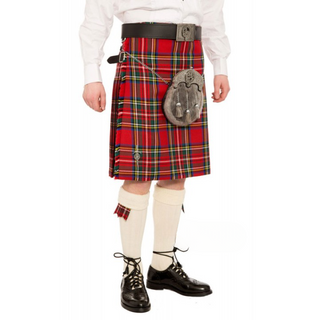Plan ahead! A kilt is a work of art that takes time to produce, so please allow us at least 16 weeks for this product to be produced and shipped to you!
The 9-yard kilt is recommended for gentlemen with larger seat (hip) sizes (between 46" and 52") to ensure a fuller feel and finer pleating. Kilt straps on this kilt are set with an allowance of 0.5" tighter and 1.5" looser.
As with all our kilts, this garment is made in Scotland by trained kilt makers. Each kilt is canvas lined with 3 buckles to ensure an excellent fit.
Kilt pin and sporran may be purchased separately.
Tartan Finder Disclaimer:
As each of the mills has supplied their own images, or they have been taken from fabric samples, please note that the setts are not to scale when comparing tartans of different mills. Also, as screen resolutions vary, colours may differ slightly from those seen here. If unsure, we’d encourage you to purchase a swatch of the fabric before buying.
Measuring advice:
- Waist: measure firmly around waist at navel (belly button) height.
- Seat: measure around the largest part of the seat area.
- Kilt Length: measure from the top of the hip at navel height to the top or middle of the knee. As a rule of thumb, your kilt length should be no shorter than a third of your height. It's always best to get someone to help with this measurement, as you'll lean forward and shorten the length when doing it yourself.
- Height: provide this in feet and inches.
Don't worry if these seem daunting, it's not as hard as it might sound! We have many years experience getting kilts made for people of all sizes, and will check with you if anything seems unusual.
This item is made to order in Scotland, with a standard turnaround time of 12-16 weeks.
Pleating at the back can either be 'to the sett' meaning it continues the pattern of the tartan, while 'to the stripe' means each pleat carries a uniform stripe from the tartan.
If you have any queries regarding the measurement process, the pleating options, or would like some additional information before placing your order, please e-mail us at sales@plaidplace.com
Additional Information about fabric choices:
This kilt is machine stitched and hand finished from 9 yards of worsted wool, available in our full range of tartans from Lochcarron of Scotland, Marton Mills, Strathmore Woollens and House of Edgar.
What’s the difference?
Each mill uses different methods, looms and finishes on their cloth.
In general, heavyweight is perhaps the best material for making kilts, it looks and feels great, while also being fairly crease resistant (when the kilt is treated and kept properly anyway). However, it’s not always best for warm climates, and sometimes folk prefer a lighter option, so mediumweight is a great alternative. Lightweight would be recommended especially for very warm climates.
Strathmore (W60) and House of Edgar (Mediumweight and Old and Rare - but not their Nevis, Hebridean or Emblem ranges) have a traditional selvedge made on a shuttle loom, which means the bottom of the cloth (and so the kilt) is exactly the same thickness as the rest of the cloth. These traditional edges are only available in the mediumweight cloths.
Marton Mills and Lochcarron use a tuck-in selvedge, where the end threads are ‘tucked’ back into the weave. This means the bottom half-inch of the cloth (and the kilt) can be a little thicker than the rest (not too much though, and not enough to distort the shape of the pleating at the back). It also means the tucked threads can poke up out of the cloth.
Don’t worry if this doesn’t mean anything to you! Both are of kilting quality and produce a kilt that will last you a lifetime. The difference is subtle and can be apparent on close inspection, but not so much from a distance.
Plan ahead! A kilt is a work of art that takes time to produce, so please allow us at least 16 weeks for this product to be produced and shipped to you!
The 9-yard kilt is recommended for gentlemen with larger seat (hip) sizes (between 46" and 52") to ensure a fuller feel and finer pleating. Kilt straps on this kilt are set with an allowance of 0.5" tighter and 1.5" looser.
As with all our kilts, this garment is made in Scotland by trained kilt makers. Each kilt is canvas lined with 3 buckles to ensure an excellent fit.
Kilt pin and sporran may be purchased separately.
Tartan Finder Disclaimer:
As each of the mills has supplied their own images, or they have been taken from fabric samples, please note that the setts are not to scale when comparing tartans of different mills. Also, as screen resolutions vary, colours may differ slightly from those seen here. If unsure, we’d encourage you to purchase a swatch of the fabric before buying.
Measuring advice:
- Waist: measure firmly around waist at navel (belly button) height.
- Seat: measure around the largest part of the seat area.
- Kilt Length: measure from the top of the hip at navel height to the top or middle of the knee. As a rule of thumb, your kilt length should be no shorter than a third of your height. It's always best to get someone to help with this measurement, as you'll lean forward and shorten the length when doing it yourself.
- Height: provide this in feet and inches.
Don't worry if these seem daunting, it's not as hard as it might sound! We have many years experience getting kilts made for people of all sizes, and will check with you if anything seems unusual.
This item is made to order in Scotland, with a standard turnaround time of 12-16 weeks.
Pleating at the back can either be 'to the sett' meaning it continues the pattern of the tartan, while 'to the stripe' means each pleat carries a uniform stripe from the tartan.
If you have any queries regarding the measurement process, the pleating options, or would like some additional information before placing your order, please e-mail us at sales@plaidplace.com
Additional Information about fabric choices:
This kilt is machine stitched and hand finished from 9 yards of worsted wool, available in our full range of tartans from Lochcarron of Scotland, Marton Mills, Strathmore Woollens and House of Edgar.
What’s the difference?
Each mill uses different methods, looms and finishes on their cloth.
In general, heavyweight is perhaps the best material for making kilts, it looks and feels great, while also being fairly crease resistant (when the kilt is treated and kept properly anyway). However, it’s not always best for warm climates, and sometimes folk prefer a lighter option, so mediumweight is a great alternative. Lightweight would be recommended especially for very warm climates.
Strathmore (W60) and House of Edgar (Mediumweight and Old and Rare - but not their Nevis, Hebridean or Emblem ranges) have a traditional selvedge made on a shuttle loom, which means the bottom of the cloth (and so the kilt) is exactly the same thickness as the rest of the cloth. These traditional edges are only available in the mediumweight cloths.
Marton Mills and Lochcarron use a tuck-in selvedge, where the end threads are ‘tucked’ back into the weave. This means the bottom half-inch of the cloth (and the kilt) can be a little thicker than the rest (not too much though, and not enough to distort the shape of the pleating at the back). It also means the tucked threads can poke up out of the cloth.
Don’t worry if this doesn’t mean anything to you! Both are of kilting quality and produce a kilt that will last you a lifetime. The difference is subtle and can be apparent on close inspection, but not so much from a distance.

